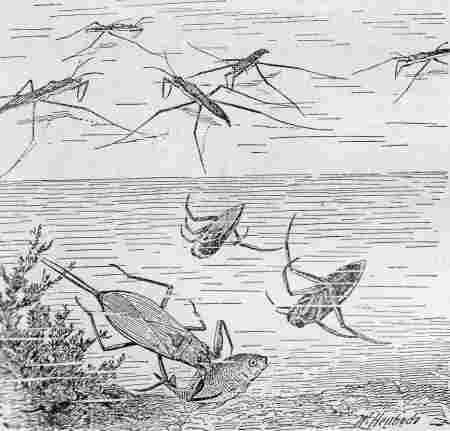Lesser water boatman
They can be found in every pond and ditch.
You only notice them because they surface every 2 minutes.
Only for some seconds they remain just under the surface to
take a breath. The air is transported in the space under
the wings. Then they'll dive to the bottom.
The lesser water boatman is mainly herbivorous, so feeding
on plants, dead or alive that can be found near the
bottom of the ditch or pond. But they also feed on
dead animals.
Flying of the lesser water boatman
The lesset water boatman leaves the water in spring,
a flies around. When returning into the water, they'll
splash down.
up and down of the lesser water boatman
Just like a spermwhale , they are just a short moment on
the surface to breath, and then dive directly to the
pond bottom. They swim by using their paddle-like hind legs
in a jerky motion. Diving down take much more effort and
time then going to the surface, as there is an air bubble
attached to the insect.
the air bubble of the water boatman
Like the atmosphere, the bubble contains primarily both
oxygen and nitrogen, the oxygen is used and transformed
in carbondioxide that dissolves in the water. So the nitrogen
ratio in the air bubble will increase, pushing the nitrogen
to dissolve in the water by diffusion. But there will also
be as little oxygen from the water that will diffuse into
the airbubble, the airbubble will act as a physical gill.
In the end, this process will shrink the airbubble
and forces the water boatmen to return to the surface.
But there will also be as little oxygen from the
water that will diffuse into the airbubble, the airbubble
will act as a long. This explains why the air bubble
becomes smaller, but also why this insects needs oxygenrich
water. There has been scientific research done by Roger
Seymour of the University of Adelaide in South Africa
and Stefan Hetz from Humboldt University in Germany,
who measured oxygen in the air bubble of diving spiders.
Lesser and greater water boatman
Altough they have an almost simular name and appearance,
they are not related.
The lesser waterboatman swim on its fronts. The lesser
waterboatman is herbivores and lives mainly on the bottom
of the pond, and is brown or golden in color. The greater
waterboatman sticks to the surface.
Lesser water boatman, male
The male can rub its front legs against a ridge (stridulitrum)
on the side of its head, and that way producing a loud
mating call to attract females, this is called stridulation.
grab an air bubble at the surface and then use their paddle-like hind legs to swim to the lake bottom. Even while staying in the water the boatman will swim to the waters surface to grab a fresh air bubble and then back down to the lake bottom. Most of this water travel is therefore almost straight up and down in short jerky movements. The buoyancy of the air bubble makes the trip to the surface much faster than the return trip to the lake bottom, which requires constant paddling.

This nymf of the Corixa is capable to get its oxygen through the skin.
The picture was made by
Jaap Costo Budde
the lesser waterboatman in the terrarium
The lesser waterboatman is one of those very few animals
that can live in a terrarium. If will find its food on
the bottom , but thats not enough to keep it alive for
a long time, you need to provide it with some food.

Water Scater, backswimmer and Water scorpion, feeding on a stickelback.
bugs or Heteroptera
On this website you will find:
te vinden:
water stick insect or Ranatra linearis
Green shield bug
Firebug
backswimmer
backswimmer
water scorpion
water boatman
|
|